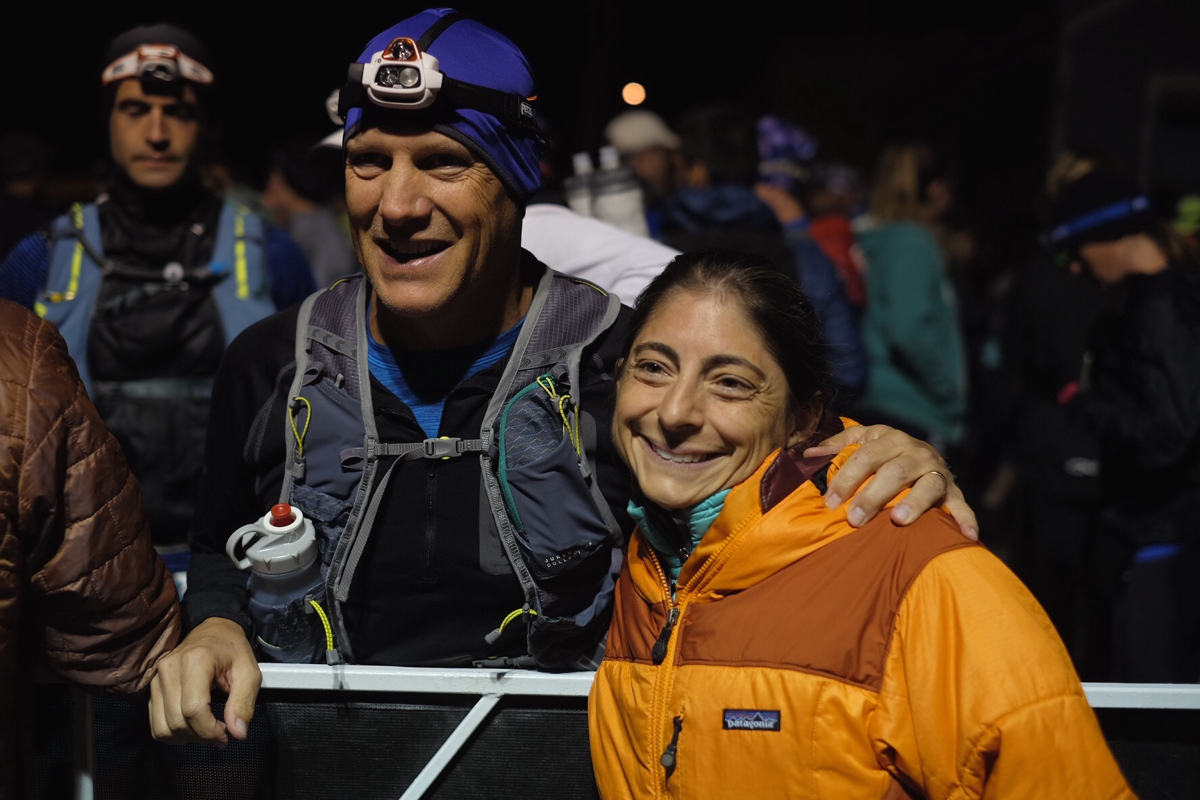[Editor’s Note: This article was written by the Trail Sisters’s Liza Howard.]
“We’re not going to make the cutoff.”
Rick Yelverton and I were hiking down from Hope Pass at the Leadville Trail 100 Mile, and if you’d seen us, you’d have thought: Those two are moving! You’d have also wondered why my pack was roughly eight times the size of Rick’s pack. (In my defense, it was going to be 60 degrees Fahrenheit colder than it was when I left home in San Antonio, Texas, and, also, I’m from the Boy Scout/mom’s purse school of pacing. Always be prepared and keep it in a big bag on your person.)
Rick had cleared the 50-mile aid station at Winfield with just seconds to spare. People were yelling at him as he ran down the road into the station: “Don’t stop! Keep moving! Go! Go! Go!”
He hiked in one end of the turnaround tent and out the other without making eye contact with anyone. I hurried after him, ready to body block race officials with my large mom pack.
Rick looked good. I handed him a tiny can of Coke. We had four hours to cover some 11 miles and climb and descend about 3,000 feet before the the next cutoff. We’d need to maintain a 20-minute pace. It was possible. He was hiking at a 14- and 15-minute pace now.
And then the altitude got Rick. He slowed to Everest pace. (Kilian has ruined this analogy, but you know what I mean.) Still, he moved forward relentlessly. His effort was monumental. I will pull up the memory of it the next time I’m struggling in a race. We got up and over the pass, stopping only to put on headlamps and ask for more Coke at the Hopeless Aid Station.
Rick had moved so well and so consistently that I was shocked when I checked the time and saw we had 40 minutes to make the cutoff. Twenty minutes later, we were still descending. I told Rick the time. He picked up his pace. We’d passed 15 runners on the ascent, and we flew past a handful of folks on the descent. It didn’t matter.
I frowned and told him we weren’t going to make it.
He was quiet for the briefest moment. He kept hiking at a fast pace. Then he said, “Okay.”
“I’m really sorry,” I said. I’m Rick’s coach, and I knew exactly how much effort he’d put into running this race. We both knew he could go another 40 miles. Maybe he’d finish in 33 hours. I turned over a litany of ultrarunning truths in my mind, wondering which one might not sound hackneyed 18 hours and innumerable tiny cans of Coke into a 100 miler.
Then Rick said, “It’s okay. This has been an excellent training run for next year. You know, a guy at the camp told me getting a Leadville belt buckle can take a few years. He’s right. It took me awhile to get going when I started doing Ironman races, too. Today was awesome.”
He was entirely sincere.
I smiled at the back of his head. No self-pity. No self-loathing. No catastrophizing. He’d given 100%, come up short, and immediately filed the experience under ‘not yet.’ He epitomized Carol Dweck’s growth mindset that Andy Jones-Wilkins wrote about in his Taproom column a few years ago. Check out that article for a wonderful summary of Dweck’s observations about the power of mindset.
Dr. Dweck calls Rick’s way of thinking about his performance at Leadville a “growth mindset.” People with this mindset believe effort is necessary for mastery. They see difficulties and failures as stepping stones. They wholeheartedly embrace learning opportunities. I had never seen a growth minder in action until I paced Rick at Leadville. To be honest, they sounded too good to be true. Embracing ‘learning opportunities.’ Right.
Chalk my cynicism up to having a full-blown “fixed mindset.” My knee-jerk interpretation of a bad race–say coming in second at Leadville a few years ago? “I’m not really talented.” “I’m not a good runner anymore.” “I shouldn’t have run this race.” “People are going to think I’m no good.” (Yes, like you, I realize these are not accurate or helpful thoughts. They are the ugly ones that hound me, though.)
You can see the power of a growth mindset versus a fixed mindset and the cascade of effects that each can have for a runner.
When I failed to meet my Leadville goal, my confidence was shaken for months. I worried about whether my results were a bellwether of races to come. The worry consumed me and made my training tedious. Each bad long run seemed like further evidence of my decline. Nothing was fun. I avoided racing. My training suffered. My husband suffered. And this was after placing second with a PR.
Rick, on the other hand, has already made plans to come back to Leadville. We’ve talked about what we’ll add to his training. He’s excited to get running again. His family is excited for him. I have no doubt he’ll be walking around wearing a ridiculously large buckle this time next year.

Rick and Liza at the 4 a.m. 2017 Leadville Trail 100 Mile start. (I’m thinking about coffee.) Photo: Kate Yelverton
So the real question is, how does a runner develop a growth mindset if they’re not a magical unicorn like Rick already? Here are a few ideas:
- Recognize when you’re evaluating your racing and training from a fixed mindset and choose growth instead:
- You struggle to keep up with friends or to run a certain pace.
- Fixed Mindset: I’m out of shape and I’m not a good runner right now.
- Growth Mindset: All runners have bad workouts from time to time.
- You DNF at your goal race.
- Fixed Mindset: I failed.
- Growth Mindset: I didn’t finish yet. (Dweck thinks “yet” is very powerful word. I love it too. I have not put together a good performance at Marathon des Sables yet. I have not figured out my asthma issues yet. I have not cleaned the bathroom yet.)
- You struggle to keep up with friends or to run a certain pace.
- Answer the questions: Why do I run? What do I want from running? How do I want running to change me? Write the answers down and refer to them before you race and before hard training. They’re effective touchstones that can shove you toward growth. (If it turns out your answers really are, I run because it makes me feel important and special, work on finding other motives. A need for validation is an impossible place to excel from.)
- Be realistic about how your timeline and how much effort will be necessary. If you have young kids, or you work, or you’re in school, or you do all three and juggle a slew of other responsibilities and rarely get eight hours of sleep a night and can only run on roads at sea level, take all that into account when creating your plan for the year and when you think about the next three years.
- Write a race report. It’ll help you identify a fixed mindset and give you a place to practice celebrating learning.
- Seek out opportunities to learn through failure. Treat failures like a baby learning to walk does. Fall down. Get up. Fall down. Get up. Cry, laugh. Fall down. Get up. Again and again and again until you’re a little terror pulling down things from tabletops, I mean, until you’ve achieved your goal. Then set a new goal.
- Figure out how to have fun training. Hard work does not preclude fun. If you’re having fun, you’ll value the process. And if you can value the learning more than the results, you’ll likely reach your running potential more quickly than you would otherwise. (Also, you’ll be having fun.)
Call for Comments (from Liza)
- Do you know someone who has a growth mindset? Tell me how you think it impacts their running (and definitely hang out with them more.)
- How do you think you can move from a fixed mindset to a growth mindset in running?
- Are you a growth minder? If so, can you share your rainbow wisdom?

